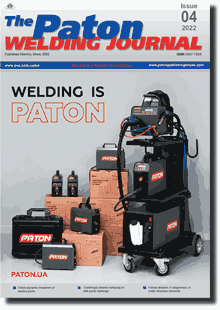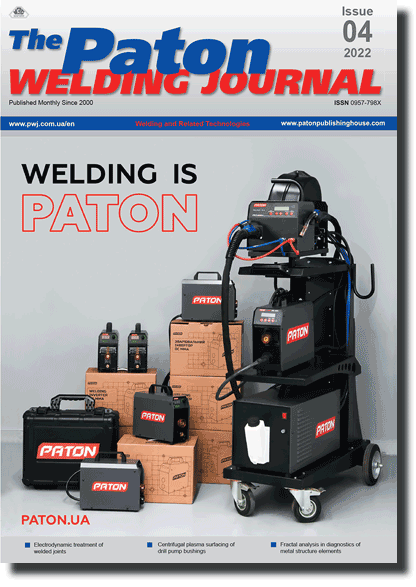| 2022 №04 (04) |
DOI of Article 10.37434/tpwj2022.04.05 |
2022 №04 (06) |

The Paton Welding Journal, 2022, #4, 26-33 pages
Formation of a joint between deposited and base metals during laser cladding of a nickel-based powder onto a copper-based alloy
F. Bourahima1, T. Baudin2, M. Rege1, V. Ji2, F. Brisset2, A. Zavdoveev3, A.L. Helbert2
1Etablissements Chpolansky, 3 Rue Angiboust, 91 462 Marcoussis, France
2ICMMO, SP2M, Université Paris-Saclay, UMR CNRS 8182, bât.410, 91405 ORSAY, France
3E.O. Paton Electric Welding Institute of the NASU. 11 Kazymyr Malevych Str., 03150, Kyiv, Ukraine. E-mail: paton39@ukr.net
Abstract
Laser cladding is an alternative method to other cladding techniques such as Plasma Transfer Arc (PTA) or blowtorch for surface treatment in the glass industry. It aims to produce dense, high-quality coatings on a non-planar surface without affecting its thermal and mechanical properties. In this study, Ni-based coatings were coated onto Cu-Ni-Al substrate using a 3 JET nozzle technique. During laser cladding, good metallurgical bonding is necessary to ensure the further surfacing process technique. A microstructural analysis was conducted, and the mechanical properties were then evaluated with microhardness analysis to link process parameters to coating bonding quality. A calculation of the power attenuation attempts to explain the impact of the powder distribution on the bonding. This work revealed that a chemical dilution zone exists between coating and substrate and is necessary for perfect metallurgical bonding. The heterogeneous bonding, observed through the section, along the curved interface coating/substrate, has been linked to the Gaussian distribution of the powder that attenuates the input power. The attenuated power was measured all along the interface. 35 Ref., 2 Tabl., 10 Fig.
Keywords: laser cladding, power attenuation, powder distribution, dilution zone
Received: 22.03.2022
Accepted: 30.06.2022
References
1. Rege, M., Van Linden, S. (2016) Stage de formation aux techniques de rechargement dans l`industrie verrière, Marcoussis.2. Oberländer, B.C., Lugscheider, E. (1992) Comparison of properties of coatings produced by laser cladding and conventional methods. Mater. Sci. Technol. (United Kingdom). 8, 657-665. https://doi.org/10.1179/mst.1992.8.8.657
3. Steen, W.M., Mazumder, J. (2010) Laser Material Processing, 4th ed., Springer. https://doi.org/10.1007/978-1-84996-062-5
4. Ryabtsev, I.A., Perepletchikov, E.F. (1992) Properties of alloys based on Fe, Ni, Co, deposited by laser-powder method. Sat. «Deposited metal. Composition, structure and properties ». Kyiv, E.O. Paton, S.23-26.
5. Arabi Jeshvaghani, R., Jaberzadeh, M., Zohdi, H., Shamanian, M. (2014) Microstructural study and wear behavior of ductile iron surface alloyed by Inconel 617. Mater. Des. 54, 491-497. https://doi.org/10.1016/j.matdes.2013.08.059
6. Liu, H., Hao, J., Han, Z. et al. (2016) Microstructural evolution and bonding characteristic in multi-layer laser cladding of NiCoCr alloy on compacted graphite cast iron. J. Mater. Process. Technol. 232, 153-164. https://doi.org/10.1016/j.jmatprotec.2016.02.001
7. Balu, P., Rea, E., Deng, J. (2015) Laser cladding of nickel- based alloy coatings on copper substrates. Proc. SPIE, 9657, 1-10. https://doi.org/10.1117/12.2175966
8. Saqib, S., Urbanic, R.J., Aggarwal, K. (2014) Analysis of laser cladding bead morphology for developing additive manufacturing travel paths. Procedia CIRP, 17, 824-829. https://doi.org/10.1016/j.procir.2014.01.098
9. Tao Y.F., Li J., Lv Y.H., Hu L.F. (2017) Effect of heat treatment on residual stress and wear behaviors of the TiNi/Ti2Ni based laser cladding composite coatings. Opt. Laser Technol., 97, 379-389. https://doi.org/10.1016/j.optlastec.2017.07.029
10. Kim, C.K., Choi, S.G., Kim, J.H. et al. (2020) Characterization of surface modification by laser cladding using low melting point metal. J. Ind. Eng. Chem., 87, 54-59. https://doi.org/10.1016/j.jiec.2020.03.010
11. Kumar, S., Roy, S. (2006) The effect of Marangoni-Rayleigh- Benard convection on the process parameters in blown-powder laser cladding process-A numerical investigation, Numer. Heat Transf. Part A Appl., 50, 689-704. https://doi.org/10.1080/10407780600605286
12. Rienstra, S.W., Chandra, T. (2001) Analytical approximations to the viscous glass-flow problem in the mould-plunger pressing process, including an investigation of boundary conditions. J. Eng., Math. 39, 241-259. https://doi.org/10.1023/A:1004883310709
13. Toyserkani, E., Amir, K., Stephen, C. (2006) Laser Cladding, CRC PRESS.
14. Liu, J., Yu H., Chen, C. et al. (2017) Research and development status of laser cladding on magnesium alloys: A review. Opt. Lasers Eng., 93, 195-210. https://doi.org/10.1016/j.optlaseng.2017.02.007
15. Luo, X., Li, J., Li, G.J. (2015) Effect of NiCrBSi content on microstructural evolution, cracking susceptibility and wear behaviors of laser cladding WC/Ni-NiCrBSi composite coatings. J. Alloys Compd., 626, 102-111. https://doi.org/10.1016/j.jallcom.2014.11.161
16. Pereira, J.C., Zambrano, J.C., Rayón, E. et al. (2018) Mechanical and microstructural characterization of MCrAlY coatings produced by laser cladding: The influence of the Ni, Co and Al content. Surf. Coatings Technol., 338, 22-31. https://doi.org/10.1016/j.surfcoat.2018.01.073
17. Adesina O.S., Obadele B.A., Farotade G.A. et al. (2020) Influence of phase composition and microstructure on corrosion behavior of laser based Ti-Co-Ni ternary coatings on Ti-6Al-4V alloy. J. Alloys Compd., 827, 1-11. https://doi.org/10.1016/j.jallcom.2020.154245
18. Wang, S., Liu, C. (2019) Real-time monitoring of chemical composition in nickel-based laser cladding layer by emission spectroscopy analysis. Materials (Basel)., 12, 1-15. https://doi.org/10.3390/ma12162637
19. Babinets, A.A., Ryabtsev, I.O., Lentyugov, I.P. et al. (2020) Problems and prospects of surfacing of copper and copper parts by wear-resistant layers (Review). TPWJ, 5, 15-23. https://doi.org/10.37434/tpwj2020.05.03
20. Zhang, Y., Tu, Y., Xi, M., Shi, L. (2008) Characterization on laser clad nickel based alloy coating on pure copper. Surf. Coatings Technol., 202, 5924-5928. https://doi.org/10.1016/j.surfcoat.2008.06.163
21. F. Bourahima, A. Helbert, M. Rege, V. Ji, D. Solas, et al. (2019) Laser cladding of Ni based powder on a Cu-Ni-Al glassmold: Influence of the process parameters on bonding quality and coating geometry. Journal of Alloys and Compounds, Elsevier, 771, pp.1018-1028. https://doi.org/10.1016/j.jallcom.2018.09.004
22. Ferreira, E., Dal, M., Colin, C. et al. (2020) Experimental and numerical analysis of gas/powder flow for different LMD nozzles. Metals (Basel)., 10, 1-20. https://doi.org/10.3390/met10050667
23. Cheikh, H. El, Courant, B., Branchu, S. et al. (2012) Analysis and prediction of single laser tracks geometrical characteristics in coaxial laser cladding process. Opt. Lasers Eng., 50, 413-422. https://doi.org/10.1016/j.optlaseng.2011.10.014
24. Pouzet, S., Peyre, P., Gorny, C. et al. (2016) Additive layer manufacturing of titanium matrix composites using the direct metal deposition laser process. Mater. Sci. Eng. A., 677, 171- 181. https://doi.org/10.1016/j.msea.2016.09.002
25. Song ,B., Yu, T., Jiang, X. et al. (2020) The relationship between convection mechanism and solidification structure of the iron-based molten pool in metal laser direct deposition. Int. J. Mech. Sci., 165, 1-14. https://doi.org/10.1016/j.ijmecsci.2019.105207
26. Pereira, J.C., Zambrano, J.C., Tobar, M.J. et al. (2015) High temperature oxidation behavior of laser cladding MCrAlY coatings on austenitic stainless steel. Surf. Coatings Technol., 270, 243-248. https://doi.org/10.1016/j.surfcoat.2015.02.050
27. Pan, C., Li, X., Zhang, R. et al. (2021) Research on microstructural and property evolution in laser cladded HAZ. Surf. Eng., 37, 1514-1522. https://doi.org/10.1080/02670844.2021.1929737
28. Hemmati, I., Ocelík, V., De Hosson, J.T.M. (2013) Effects of the alloy composition on phase constitution and properties of laser deposited Ni-Cr-B-Si coatings. Phys. Procedia., 41, 302-311. https://doi.org/10.1016/j.phpro.2013.03.082
29. Gourges-Lorenzon, A.-F. (1972) Durcissement et renforcement des materiaux, in: Matériaux Pour l`ingénieur, 159-170.
30. Gladkiy P.V., Perepletchikov E.F., Ryabtsev I.A. (2007) Plasma welding. Kyiv.
31. Kuskov, Yu.M., Ryabtsev, I.A., Kuzmenko, O.G., Lentyugov, I.P. (2020) Electroslag technologies for surfacing and recycling of metal and metal-containing wastes. Kyiv.
32. Tabernero, I., Lamikiz, A., Martínez, S. et al. (2012) Modelling of energy attenuation due to powder flow-laser beam interaction during laser cladding process. J. Mater. Process. Technol., 212, 516-522. https://doi.org/10.1016/j.jmatprotec.2011.10.019
33. Qi, H., Mazumder, J., Ki, H. (2006) Numerical simulation of heat transfer and fluid flow in coaxial laser cladding process for direct metal deposition. J. Appl. Phys. 100, 1-11. https://doi.org/10.1063/1.2209807
34. Peyre, P., Aubry, P., Fabbro, R. et al. (2008) Analytical and numerical modelling of the direct metal deposition laser process. J. Phys. D. Appl. Phys., 41, 1-10. https://doi.org/10.1088/0022-3727/41/2/025403
35. Bourahima, F., Helbert, A., Ott, F. et al. (2021) Multi-Scale Characterization by Neutronography and Electron Diffraction of Ni Coating on Cu-Ni-Al or Cast-Iron Glass Molds after Laser Cladding. Trans Tech Publ. Ltd., 1016, 297-302. https://doi.org/10.4028/www.scientific.net/MSF.1016.297
Suggested Citation
F. Bourahima, T. Baudin, M. Rege, V. Ji, F. Brisset, A. Zavdoveev, A.L. Helbert (2022) Formation of a joint between deposited and base metals during laser cladding of a nickel-based powder onto a copper-based alloy. The Paton Welding J., 04, 26-33.The cost of subscription/purchase order journals or individual articles
| Journal/Currency | Annual Set | 1 issue printed |
1 issue |
one article |
| TPWJ/USD | 384 $ | 32 $ | 26 $ | 13 $ |
| TPWJ/EUR | 348 € | 29 € | 24 € | 12 € |
| TPWJ/UAH | 7200 UAH | 600 UAH | 600 UAH | 280 UAH |
| AS/UAH | 1800 UAH | 300 UAH | 300 UAH | 150 UAH |
| AS/USD | 192 $ | 32 $ | 26 $ | 13 $ |
| AS/EUR | 180 € | 30 € | 25 € | 12 € |
| SEM/UAH | 1200 UAH | 300 UAH | 300 UAH | 150 UAH |
| SEM/USD | 128 $ | 32 $ | 26 $ | 13 $ |
| SEM/EUR | 120 € | 30 € | 25 € | 12 € |
| TDNK/UAH | 1200 UAH | 300 UAH | 300 UAH | 150 UAH |
| TDNK/USD | 128 $ | 32 $ | 26 $ | 13 $ |
| TDNK/EUR | 120 € | 30 € | 25 € | 15 € |
AS = «Automatic Welding» - 6 issues per year;
TPWJ = «PATON WELDING JOURNAL» - 12 issues per year;
SEM = «Electrometallurgy Today» - 4 issues per year;
TDNK = «Technical Diagnostics and Non-Destructive Testing» - 4 issues per year.


